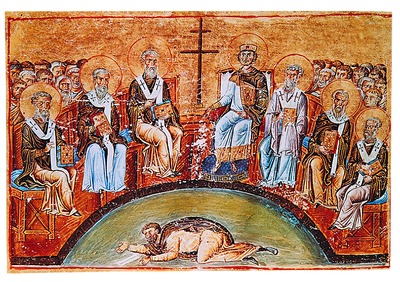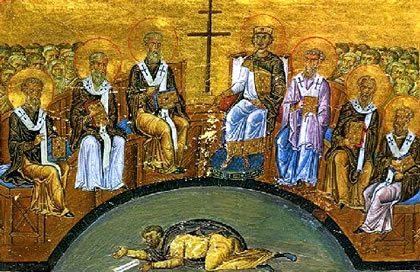Second Council of Nicaea
Convocation
The Second Council of Nicaea was Empress Irene in 787 in the city of Nicaea ( Iznik today / Turkey) convened southeast of Constantinople Opel. It was an ecumenical council, except as Orthodox bishops also attended by delegates from the Roman Catholic Church.
Teaching
The Second Council of Nicaea permitted, nor called in Bilderstreit the worship, but the worship of icons, but only under certain conditions.
Relying on the tradition of the Church defined the council:
" ... Both the figure of the precious and life-giving Cross, as well as venerable sacred images are to present, both with colors painted as, well as mosaics as from any other suitable material, in the holy churches of God, on sacred vessels and vestments on walls and panels as namely the image of our Lord and God and Savior Jesus Christ as well as our Lady without blemish, the holy Mother of God, and the venerated angels, and all the holy and blessed -making men. Because the more often you see the visual design, the more are those who look at them, excited to the memory of their prototypes, and to a longing for it, and to offer up them kisses and honoring prayers. Not, however, to give them real worship, within the meaning of faith in them that is due only to the divine nature! The proffered the image worship is indeed on its archetype over, and who prays to an image out, pray really to what is depicted on it. "
Herein, the Council concluded essentially on the argument of John of Damascus. The iconoclastic council of Hieria of 754 was declared invalid and the " pseudo- synod ".
To the dogmatic part of the decisions including the rules governing the election of bishops:
" ... Candidates for the episcopate must have knowledge of the Psalter and prove to be able to interpret biblical texts. Each election of a bishop, priest or deacon secular princes to remain valid. [ ... ] Bishops must be elected by all the bishops of an ecclesiastical province, with outer hindrance of at least three bishops present. The consecration is to be made when the others have given their consent letter. The oversight of the above lies with the metropolitan. "
Furthermore, numerous disciplinary measures have been adopted and inculcated:
- Against simony,
- Dresses luxury and avarice higher clerics,
- The consecration of churches without relics,
- The toleration baptized, but persisting in their old customs Jews,
- Mehrfachinkardination of clerics,
- The establishment of churches without financial foundation,
- Scandal exciting community of male and female religious,
- Especially double monasteries;
- Annual Bishops' Conferences on the level of ecclesiastical provinces,
- The establishment of church financial administrator,
- The consecration of lecturers by laying on of hands by a bishop or auxiliary bishop.
Reception and extensions
The Council applies to the Catholic Church and the Orthodox Church as the seventh ecumenical council. In Protestantism its decisions are judged very differently, of fundamental recognition to open rejection.
Charlemagne, who had not been asked, criticized to the Pope Leo III. the participation of the Roman Church at this council, because he was of the opinion that the Empress Irene should restrain themselves in religious matters as a woman and he anyway, especially in these matters, always wanted to have the last word. This led to the Carolingian " Filioque " in the Creed ( the Holy Spirit is evident not only from the Father but is from the Father and the Son ). This subtle addition was approved by Leo III. classified as heretical, but in their mutual relationship as "unimportant " because in the end only the service of God prevail, and the fact there was agreement. It announced itself already here a dispute over the appointment of bishops ( investiture controversy ) that the relationship between pope and emperor loaded in later centuries of the Middle Ages.








